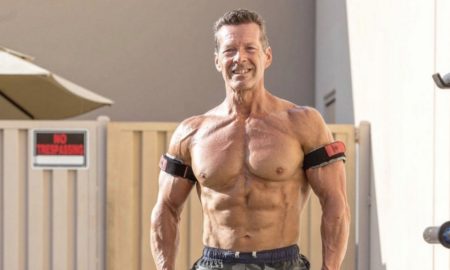 Insulinlike growth factor 1 is so named because of its resemblance to insulin. IGF-1 is synthesized both in the liver and in muscle. There are two variants of the hormone in muscle, and each is a potent stimulator of satellite cells, which are muscle stem cells and are required for muscle repair and growth. Most scientists say that IGF-1 is the primary anabolic effector of growth hormone, and GH stimulates IGF-1 synthesis in the liver. Scientists are looking at IGF-1 therapy with great interest, as it appears to reverse many of the effects of aging. As with GH, IGF-1 concentration drops with age, and many older people have 50 percent less than younger people do.
Insulinlike growth factor 1 is so named because of its resemblance to insulin. IGF-1 is synthesized both in the liver and in muscle. There are two variants of the hormone in muscle, and each is a potent stimulator of satellite cells, which are muscle stem cells and are required for muscle repair and growth. Most scientists say that IGF-1 is the primary anabolic effector of growth hormone, and GH stimulates IGF-1 synthesis in the liver. Scientists are looking at IGF-1 therapy with great interest, as it appears to reverse many of the effects of aging. As with GH, IGF-1 concentration drops with age, and many older people have 50 percent less than younger people do.
Numerous studies show that maintaining an optimal count of IGF-1 forestalls many of the typical signs of aging. For example, a lack of IGF-1 is linked to heart failure, which affects more than half of those over age 60. IGF-1 is also required to maintain brain cells, or neurons. Without a sufficient amount in the brain, neurons undergo a cellular suicidal process called apoptosis. Insufficient IGF-1 also makes muscles and connective tissue break down, resulting in the weakness and stiffness that older adults often experience.
With all these benefits, you’d think that just about every person over age 40 who’s low in the hormone would be supplementing it in some way. Thus far, however, commercial forms of IGF-1—which must be injected, as the hormone is protein based and composed of 79 amino acids in a particular sequence—are prescribed only to treat certain forms of childhood growth problems.
Because IGF-1 spurs cellular growth, some scientists voice concern that at high concentrations it could stimulate cancer. Indeed, higher amounts of IGF-1 are associated with certain forms of cancer, such as those of the prostate, breast and colon. The big debate among researchers is a chicken-and-egg argument: Does IGF-1 promote tumor growth and spread, or do tumors themselves increase IGF-1? IGF-1 is useful to tumors because it prevents their apoptosis.
[Are you looking for health, muscle and the amazing anti-aging benefits of resistance training? Get the new e-book by Steve and Becky Holman, Old School, New Body. Read the Iron Man magazine review here.]
Complicating the cancer connection is the fact that teenagers, still in a growth stage and thus producing large amounts of IGF-1, have low rates of cancer. By contrast, older adults have the highest rates of various cancers yet also have the lowest blood IGF-1 counts. A more rational scenario is that while IGF-1 doesn’t cause cancer, taking it in large doses may result in tumor activity. One recent study found that higher levels of IGF-1 are inversely associated with testicular cancer.1
Also confusing IGF-1 as a health issue is the way some animals react to the hormone. Studies with worms and other invertebrates show that a lack of IGF-1 helps extend life. Mice and rats deficient in IGF-1 live longer than rodents not deficient in it. Female mice having defects in IGF-1 cellular signaling appear to age more slowly than other rodents. Animal studies, however, usually involve lifelong exposure, which isn’t the case with human studies. The hormone may also act differently in relatively short-lived animals, such as mice and rats, than in longer-lived humans.
Preliminary studies of IGF-1 with human subjects have shown beneficial effects. For example, researchers recently examined the effects of IGF-1 on human mortality.2 Critics of IGF-1 and GH therapy often say that rather than offering a fountain of youth, the hormones may hasten death, citing the longevity of some animals that are hormone deficient. In the eight-year human mortality investigation of IGF-1, which involved 376 healthy subjects aged 73 to 94, higher amounts of IGF-1 were associated with longer life and reduced cardiovascular risk. Those with the least IGF-1 in their bodies showed nearly twice the risk of death of those who had more. Those who had a lot of age-related overall body inflammation were particularly at risk; IGF-1 appears to douse the flames of out-of-control inflammation. Inflammation plays a major role in nearly all causes of premature death, including cardiovascular disease, cancer and such degenerative brain diseases as Alzheimer’s and Parkinson’s.
One major theory of why we age relates to cellular structures called mitochondria, the site of energy production and fat oxidation. Because mitochondria are the cell’s power supply, when they die or cease to function, so does the whole cell. The main cause of mitochondrial death is oxidation. The high rate of energy production in mitochondria also generates the highest rate of free-radical production in the body. By-products of oxygen metabolism, free radicals attack cell membranes. Mitochondria have extensive fat-based membranes, making them particularly prone to oxidation.
If you can maintain mitochondria as you age, the process of aging should slow down, as should the incidence of age-related degenerative disease. A new study shows that one way that IGF-1 may retard aging is by protecting mitochondria.3 Loss of mitochondria isn’t usually an issue in young people because of their higher IGF-1 counts. In the study, giving IGF-1 to aging rats normalized mitochondrial oxidative damage and function while reducing free-radical generation.
Another study done by the same researchers also provided low doses of IGF-1 to aging rats.4 Old rats deficient in IGF-1 have a lack of serum antioxidants, which were restored with IGF-1. Older rats also have more glucose, insulin, fat and cholesterol in their blood. All those metabolic abnormalities were corrected when the rodents got low doses of IGF-1. What happened in the study is important because insulin resistance increases with age and is often linked to a loss of lean mass, mainly muscle. Insulin resistance results in insulin spikes in the blood, which are linked to premature aging and diabetes, itself a cause of premature death.
The study also showed that old rats suffer brain and liver damage because of inadequate antioxidant defenses, but the low IGF-1 dose normalized antioxidant protection as well as mitochondrial dysfunction. Low-dose IGF-1 also increased testosterone, not a minor effect for anyone who wants to maintain muscle size and strength with the passing years.
Does that mean you should consider taking IGF-1 injections as a means of slowing the aging process? If you’re deficient in the hormone, you will more likely be given GH itself. Since GH increases IGF-1, the benefits will be similar. Also, most physicians have more experience in providing GH than IGF-1, so the optimal doses of GH are better established. Drug forms of IGF-1 were approved by the United States Food and Drug Administration in 2005, but one form was removed from the market in 2007, leaving only one (Increlex) available. Athletes and bodybuilders have used a form called long R3 IGF-1 for years. It’s structured to last longer in the blood, thus extending its active time.
Taking too much IGF-1, as some bodybuilders and athletes do, could lead to problems. The primary side effect of large doses of IGF-1 is hypoglycemia, or low blood sugar, which points up similarities between insulin and IGF-1. In other words, large doses of IGF-1 could start to act like insulin. That isn’t likely to happen with IGF-1 drug forms that also include IGF-binding proteins, which extend and delay the activity of the hormone. Unlike insulin, IGF-1 doesn’t stimulate bodyfat synthesis, although it does stimulate internal organ growth, resulting in the bloated abdomens you see on some athletes. That occurs only with doses far bigger than you’d ever use for antiaging purposes. The same holds true for GH: Small doses are beneficial, but large doses place you in unknown biophysical territory.
In the near future gene therapy will be available for placing IGF-1-producing genes directly in muscle. Preliminary studies with rodents show startling gains in muscle size and a 35 percent increase in strength with the technique. The idea is that the therapy will eliminate the extensive weakness and loss of muscle that come with age, turning 70-year-old muscle back into 19-year-old muscle. Even so, the technique is experimental with humans and needs refining. Attempting to try it now could lead to catastrophe, such as turning on cancer-friendly genes.
For now, take solace in the fact that regular exercise is the most potent method of maintaining an optimal measure of IGF-1; weight training is the best form of exercise for that. A high-protein diet is also directly related to IGF-1, with lower protein intake linked to less total IGF-1 in the body. Some studies suggest that taking DHEA, an adrenal steroid, can normalize low IGF-1 and may be the reason that DHEA is often called an antiaging hormone.
How to Live to 90 or More
A study published last February in the Archives of Internal Medicine included some tips on how to live to 90 or more.5 Twin studies found that one-fourth of the variation in human life span is attributed to genetic factors, which means that 75 percent of life span is linked to modifiable risk factors. The research involved 2,357 men who participated in an ongoing project called the Physicians’ Health Study. At the beginning of the study in 1981, the men, average age 72, provided such information as height, weight, how often they exercised, blood pressure, cholesterol counts and so on. Twice during the first year and then once a year through 2006, they completed a questionnaire about changes in their habits, health status and ability to complete daily tasks.
A total of 870 men, or 41 percent, lived to age 90 or older. Those who made it to that age had a negative relation to several preventive risk factors—most related to common sense—such as not smoking, not having diabetes, not being fat and not having high blood pressure. Their positive relation to exercise, meanwhile, was particularly effective. The authors suggest that a 70-year-old man who doesn’t smoke, has normal weight and blood pressure and no diabetes and works out two to four times a week has a 54 percent probability of living to age 90. With the presence of adverse factors in his profile, his probability of living to 90 was reduced by the following amounts:
• Sedentary lifestyle, 44 percent
• Hypertension, 36 percent
• Obesity, 26 percent
• Smoking, 22 percent
• Three factors—such as no exercise, being fat and having diabetes—14 percent
• Five other factors, 4 percent
The primary point of the study is that if you adhere to a healthful lifestyle as you age, your chances of living longer are enhanced. Conversely, having favorable genetics but living an unhealthful lifestyle can shorten your life. One example of that was the former king of late night TV, Johnny Carson, who came from a family of long-lived adults, with both his father and grandfather living past 90. Carson, however, was a heavy smoker most of his life and also drank too much alcohol. Such behavior took its toll, overruling Carson’s favorable genetics. He died at age 79 from the effects of emphysema related to his cigarette smoking.
References
1 Chia, V.M., et al. (2008). Insulin-like growth factor-1, insulin-like growth factor-binding protein 3, and testicular germ-cell tumor risk. Am J Epidemol. 167:1438-1445.
2 Brugts, M.P., et al. (2008). Low circulating IGF-1 bioactivity in elderly men is associated with increased mortality. J Clin Endocrin Metab. 93(7):2515-2522.
3 Puche, J.E., et al. (2008). Low doses of insulin-like growth factor-1 induce mitochondrial protection in aging rats. Endocrinol. 149(5):2620-2627.
4 Garcia-Fernandez, M.G., et al. (2008). Low doses of insulin-like growth factor-1 improve insulin resistance, lipid metabolism, and oxidative damage in aging rats. Endocrinol. 149(5):2433-2442.
5 Yates, L.B. (2008). Exceptional longevity in men: Modifiable factors associated with survival and function to age 90 years. Arch Intern Med. 168:284-290. IM



















You must be logged in to post a comment Login